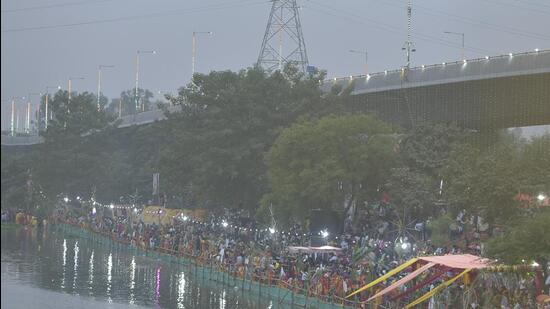The Chhath Puja celebrations along the Hindon River in Ghaziabad and Gautam Budh Nagar on Mondaywere marred by complaints over poor water quality and low water levels, leaving thousands of devotees frustrated as they gathered to perform rituals in what many described as dirty and stagnant water.
The festival, devoted to the Sun God, was celebrated across 72 locations in Ghaziabad city which included three major locations on the bank of Hindon River. According to official estimates, these three locations witness footfall of about 100,000-150,000 devotees.
The rain-fed river, which draws its flow from the Upper Ganga Canal, had not received fresh water until late Sunday evening, according to local officials. As a result, many worshippers, some fasting for days, found themselves facing ankle-deep, foul-smelling water unfit for religious offerings. By the time the water level rose on Monday afternoon, much of the early puja had already been disrupted.
“Devotees were forced to wait for hours, and many even staged a sit-in at the Hindon Chhath Ghat because the water hadn’t arrived,” said Pandit Rakesh Tiwari, national general secretary of the Purabiya Jan Kalyan Parishad, which organises Chhath festivities in Ghaziabad. “Every year we hope for clean water, and every year we end up performing the rituals in contaminated and dirty water. There is no alternative.”
“Majority of high rise residents do not go to the river as it is filthy and contaminated. So, they use the society’s swimming pools and perform puja there. With the polluted river, rituals are not possible,” said Alok Kumar, a devotee from Indirapuram.
Officials said the delay occurred because the annual maintenance shutdown of the Upper Ganga Canal, which supplies water to the Hindon, coincided with the festive season.
Fresh water was eventually released from a water escape in Meerut late Sunday evening, flowing downstream to reach Ghaziabad by night. “About 2,096 cusecs of water were released, which reached the ghats early Monday and improved the water level,” said Ranvijay Singh, additional district magistrate of Ghaziabad.
However, by the time the fresh water arrived, most of the river stretch had already been filled with wastewater from nine untreated drains flowing into the Hindon in Ghaziabad.
According to the Uttar Pradesh Pollution Control Board (UPPCB), the river’s water quality remains severely compromised.
Tests conducted in September at six sampling locations across Ghaziabad and Noida – including Karhera, Mohan Nagar, Chijarsi, and Kulesra – revealed total coliform levels ranging from 310,000 to 5.4 million most probable number (MPN) per 100ml. For context, the permissible limit is just 1,000 MPN/100ml.
The findings place the Hindon under Category ‘E’ – the lowest classification – making it unfit for drinking, bathing, or aquatic life. In such a situation, water can only be used for irrigation, industrial cooling, and controlled waste disposal.
“High coliform levels indicate untreated sewage flow into the river,” said Vipul Kumar, assistant environmental engineer with UPPCB. “Nine major drains are still being tapped. Once the ongoing projects are completed, the water quality should improve.”
But for those gathered on the ghats, the situation was disheartening.
“The water was black in colour and was not fit for drinking or bathing ritual. My family members hurriedly took a dip and then came to a temporary tap installed at the ghat to bathe again in clean water. Filthy and contaminated water is an annual feature,” said Abhishek Kumar, a devotee.
Officials visiting the sites on Sunday confirmed the poor condition of the water.
“I paid a visit to the Hindon Chhath Ghat on Sunday afternoon before the released water arrived there, and there was water from untapped drains and stinking,” said ADM Singh. “Once the released water from Meerut arrived, it offered some relief from contamination, but the problem of untreated drains continues. An integrated approach is required to clean and rejuvenate the river.”
Environmentalists said the problem was neither new nor surprising.
“The state of the river has deteriorated year after year during the past 2-3 decades. There have been plans on paper to rejuvenate it, but ground-level action is hardly visible. Once the water is released into the river, it brings in accumulated contamination from upstream areas along with contamination from untapped drains. Chhath Puja is an annual festival, and devotees have to brave odds to offer prayers in contaminated water year after year,” said Vikrant Sharma, a city-based environmentalist.

